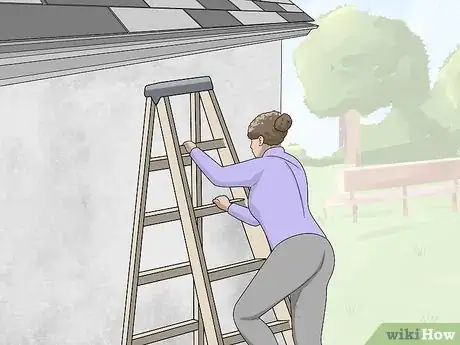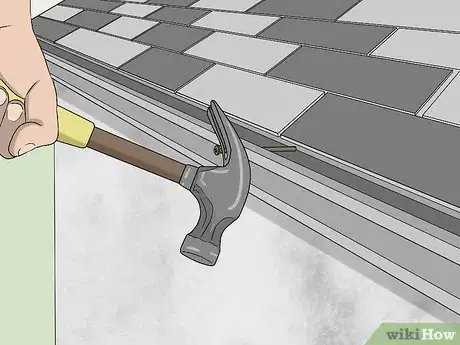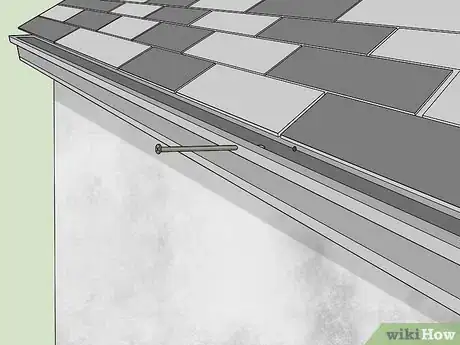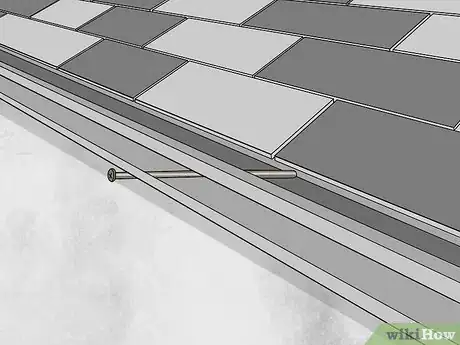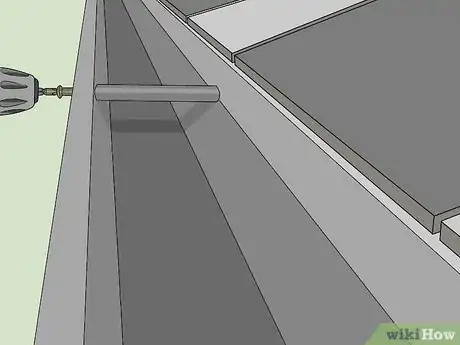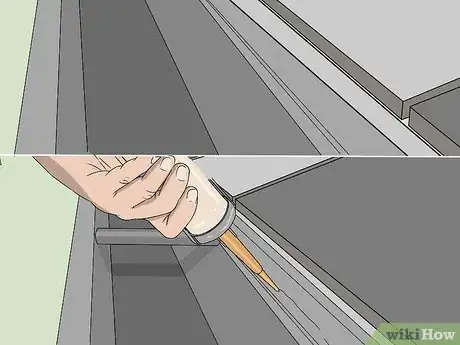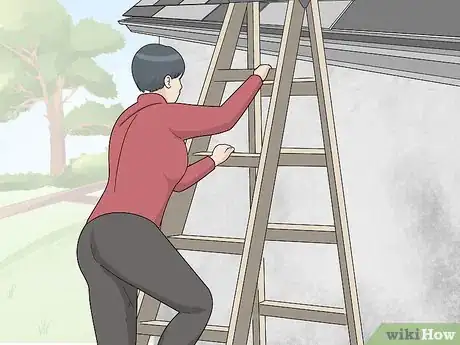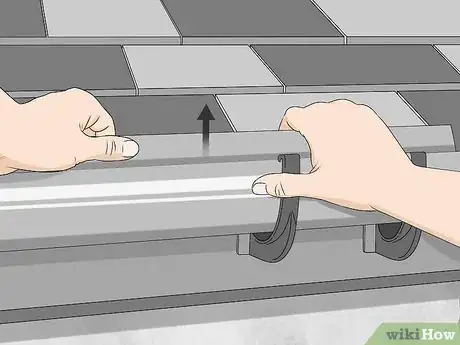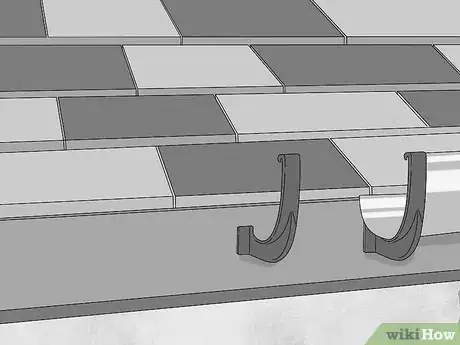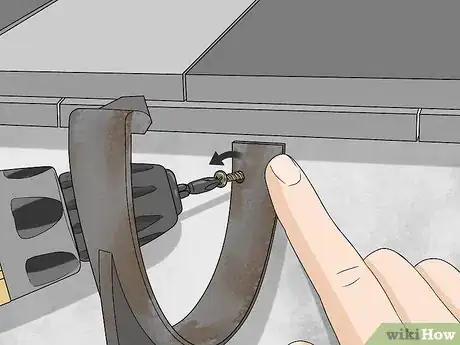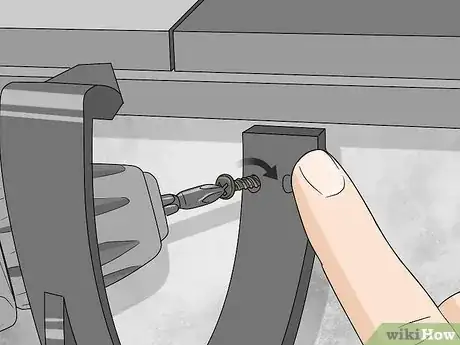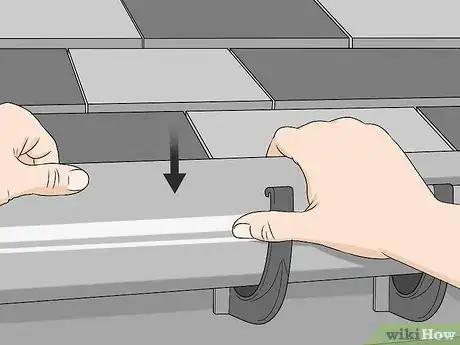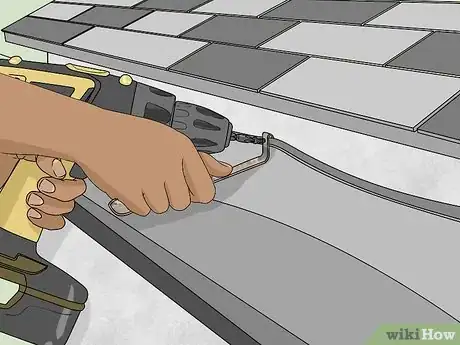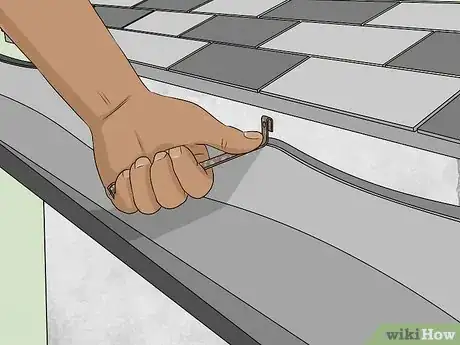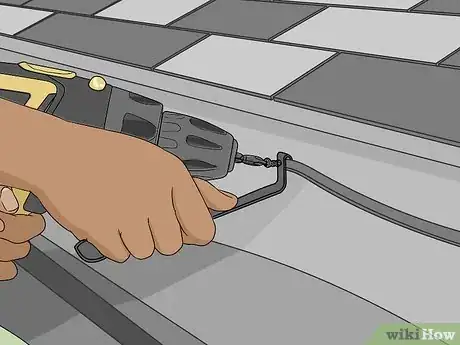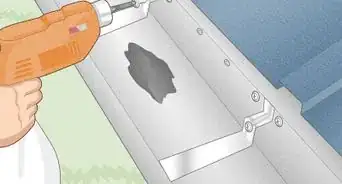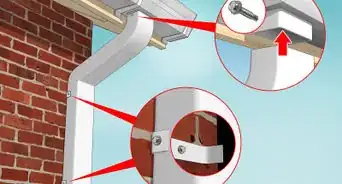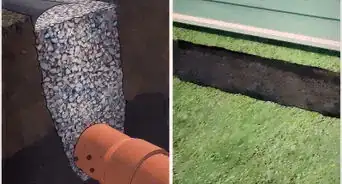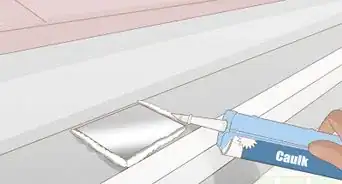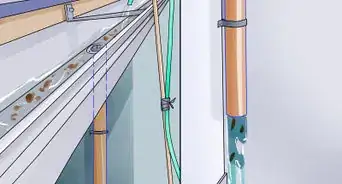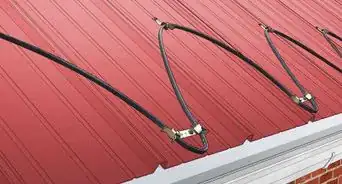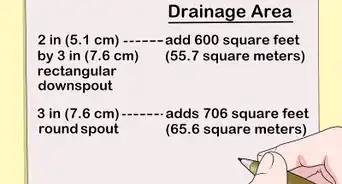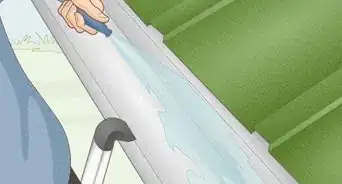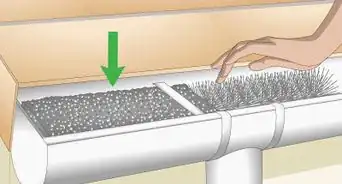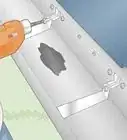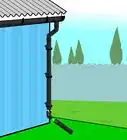This article was co-authored by Barry Zakar and by wikiHow staff writer, Hunter Rising. Barry Zakar is a professional handyman and the founder of Little Red Truck Home Services based in the San Francisco Bay Area. With over ten years of experience, Barry specializes in a variety of carpentry projects. He is skilled at constructing decks, railings, fences, gates, and various pieces of furniture. Barry also holds his MBA from John F. Kennedy University.
There are 17 references cited in this article, which can be found at the bottom of the page.
wikiHow marks an article as reader-approved once it receives enough positive feedback. In this case, 83% of readers who voted found the article helpful, earning it our reader-approved status.
This article has been viewed 161,938 times.
Over time, your gutters may sag away from the fascia board, the piece of wood that they attach to along your roof, if the fasteners break or come loose. Luckily, sagging gutters can be an easy fix with a ladder and a few simple tools. If your gutters use long spikes or nails that go through the front of the gutter, replace them with threaded spikes for a more secure fit. If you have U-shaped brackets holding your gutter from underneath, change out the ones that are broken or loose. Your gutters may also have hidden hangers on top, which look like long metal clips with screws, that you can easily swap as well. When you’re finished, your gutters will stay secure.
Steps
Changing Gutter Spikes
-
1Climb a ladder next to your sagging gutter. Divide the height of the ladder you’re using by 4 and set the base that far away from the wall. Place your ladder so both of the feet are firmly planted on the ground and lean it against your home carefully. Climb your ladder and always maintain 3 points of contact.[1]
- For example, if your ladder is 12 feet (3.7 m) tall, you would calculate 12/4 = 3 feet (0.91 m) away from the side of your home.
- Wear a tool belt so you can have both hands free while you’re using your ladder.
- Ask someone to support the bottom of the ladder for you so it doesn’t slip or fall.
- Never stand on the top step of a ladder since you’re more likely to fall.
-
2Pry out the old gutter spike with a hammer if it’s still stuck inside. Look for the end of the gutter spike sticking out from the front side of your gutter. Place the claw of your hammer on the end of the spike and pull it straight out from the gutter. Rock the hammer back and forth to help work the spike out from the fascia board if it doesn’t pull out easily. Throw the spike away when you remove it.[2]
- If the gutter spike has a screw head, then use a screwdriver instead of a hammer to remove it.
Advertisement -
3Feed a threaded gutter spike through the hole in the front of your gutter. Look for a 7–8 in (18–20 cm) gutter spike or screw that has at least 2 inches (5.1 cm) of threading on the end. Align the end of the threaded spike with the hole in the front of your gutter and push the end through by about 1⁄2 inch (1.3 cm). Don’t push the spike all the way through, or else you could bend or deform your gutters.[3]
- You can get threaded gutter spikes from your local home improvement or hardware store.
- Avoid using gutter spikes that don’t have threading since they can easily pull out from your fascia board and cause the gutters to sag again.
Tip: If the head of the new gutter spike can fit through the front hole on your gutter, drill a new hole 1⁄4 inch (0.64 cm) away from the first one that’s the same diameter as the spike’s shaft. That way, the gutter won’t slip off the spike.
-
4Slide the metal ferrule over the end of the new spike. The metal ferrule is a tube that helps support the shape of the gutter so it doesn’t bend or deform when you fasten it to your home. Place the ferrule inside the gutter and slide one end of it over the end of the threaded spike. Position the other end of the ferrule so it lines up with the hole on the back of your gutter so you can push the spike through it completely.[4]
- New gutter spikes come with metal ferrules, but you can also buy them at a hardware store if you don’t have them.
-
5Screw the gutter spike through the back hole in your gutter to secure it. Use a regular screwdriver or a drill with a screwdriver bit to turn the spike clockwise from the front of the gutter. Make sure the spike holds the gutters tight against the fascia board so it doesn’t dip or sag. Be careful not to overtighten the spike, or else you could cause the gutter to crack from the pressure.[5]
-
6Fill any gaps in the hole with wooden shims and epoxy. If the hole in the back of the gutter still feels loose, measure the size of the gap with a tape measure. Use a handsaw to cut a wood shim so it’s about 2 inches (5.1 cm) long and the same width as the gap. Cover the wood shim with a coat of clear epoxy before you push it into the gap. Tap the shim in with your hammer so it’s flush with the gutter and holds the spike firmly in place.[6]
- If you don’t have wooden shims, you can also use golf tees or pieces of scrap wood instead.
Replacing a Gutter Bracket
-
1Climb your ladder so you can easily reach your gutters. Set your ladder on flat, solid ground so the base doesn't move around while you’re climbing it. Carefully lean the ladder against the side of your home so you’re within reach of the bracket that’s loose or broken. Maintain 3 points of contact on your ladder when you’re climbing it so you don’t fall down.[7]
- Have a helper hold the base of the ladder sturdy so it doesn’t slip or fall while you’re climbing it.
- Don’t stand on the top step of your ladder.
-
2Pull the top of the brackets free from the edge of your gutter. Grab the top lip of the bracket that clips over the front edge of the gutter. Pull the top of the bracket toward you until it snaps out of place and the gutter comes loose. Continue unclipping the brackets along the section of your gutter that’s sagging.[8]
- Some brackets may screw into the front of your gutter. Use a screwdriver to undo the screws before unclipping the brackets.
-
3Remove the section of gutter that’s sagging from your roof. Have a helper climb another ladder at the opposite end of the gutter section to help support it. Grab the front lip of your gutter and pull it straight up to take out the section that’s sagging. Guide the back edge of your gutter underneath the lip of your roof so you don’t bend or break it accidentally. Carefully climb down the ladder at the same time as your helper to lower the gutter down.[9]
- If you don’t feel comfortable or you have trouble removing the gutter yourself, call a professional service to replace the bracket for you.
Warning: Don’t try to lower the gutter by yourself since you could slip and fall off your ladder.
-
4Unscrew the old bracket from where the gutter was sagging. The old bracket will usually have 2–3 screws attaching it to your fascia board. Use a screwdriver to rotate the screws counterclockwise to loosen them. Keep the screws in your pocket or set them aside where you won’t forget them since you can use them for installing your new bracket. Pull the bracket off of your home once you remove the screws. Continue removing any other brackets that are loose.[10]
- If the bracket was attached with nails originally, use the back of a claw hammer to pry them out of the wood.
-
5Secure the screws on the new bracket into the existing holes in your home. Try to get the same brackets you used before, or else they won’t match the rest of your home. Slide the screws through the holes on the replacement bracket and push them into the old holes. Turn the screws clockwise with a screwdriver to secure them to the fascia board until they’re held tightly in place.[11]
- You can buy gutter brackets from home improvement or hardware stores.
- If the screws feel loose in the old holes, then drill holes in your fascia board 1⁄2 inch (1.3 cm) to the left or right and install the brackets there instead.
-
6Push the section of the gutter into the brackets until it clicks into place. Carry the section of gutter carefully back up your ladder so you can put it back. First, position the back lip of the gutter so it goes underneath the lip of your roof. Push the front edge of the gutter straight down until you hear the tops of the brackets snap onto it.[12]
- Only push the gutter down as hard as you need to so you don’t damage or bend the brackets while you’re working.
Reinstalling Hidden Gutter Hangers
-
1Climb a ladder up to your sagging gutters. Set your ladder so the base is away from the side of your house and has both its feet on flat, sturdy ground. Place the top of the ladder against the side of your home so you can reach your sagging gutters without having to lean to the side. Climb up the ladder slowly so you’re less likely to slip and fall.[13]
- Ask someone to support your ladder so it doesn’t move or fall while you’re on it.
- Never stand on the top step of your ladder since you could easily slip.
-
2Unscrew the screw on the old gutter hanger if it’s still attached. Locate the loose hanger by looking down into your gutter and finding the one that’s sagging more than the others. Use a screwdriver or a drill to turn the screw counterclockwise so you can remove it. Pull the screw straight out from the hanger once it’s loose.[14]
- New gutter hangers usually come with screws, so you don’t need to save the old ones if you don’t want to.
Tip: Some gutter hangers have hex screws, so you may need a hex screwdriver in order to remove them.
-
3Pull the gutter hanger straight up to remove it from the gutter. Grab the end of the hanger that’s closest to the back edge of the gutter. Pull up on the back of the gutter hanger to unclip it from the edge. Tilt the hanger toward you so the front end comes loose from the front lip of the gutter and pulls out easily.[15]
- You can throw away the old hanger.
-
4Push the new hanger onto the gutter in the same place as the old one. Lower the front end of the hanger into the gutter and fit it underneath the front lip of the gutter. Position the back of the hanger so it lines up with the hole that’s already going through the back of the gutter. Press down on the back of the hanger so it clips onto the back edge of the gutter.[16]
- You can buy gutter hangers from your local hardware store.
- You can also move the hanger over 1⁄2 inch (1.3 cm) to the left or right if you don’t want to use the old holes.
-
5Use a drill or screwdriver to secure the hanger to your fascia board. Position the screws in the holes on the top of the hanger and push them in as far as they can go. Turn the screw clockwise with your screwdriver or drill until it holds the gutter firmly against your fascia board without sagging. Make sure the hanger doesn’t move around at all after you secure it in place.[17]
Warnings=
- Always maintain 3 points of contact when you’re climbing a ladder and never stand on the top step.⧼thumbs_response⧽
- If you don’t feel comfortable working on your own gutters, call a specialist or contractor to fix them for you.[18]⧼thumbs_response⧽
Things You’ll Need
Changing Gutter Spikes
- Ladder
- Claw hammer
- Threaded gutter spike
- Metal ferrule
- Screwdriver
- Wooden shims
- Handsaw
- Clear epoxy
Replacing a Gutter Bracket
- Ladder
- Screwdriver
- Gutter bracket
Reinstalling Gutter Hangers
- Ladder
- Screwdriver or drill
- Gutter hanger
References
- ↑ https://www.popularmechanics.com/home/how-to/a9631/dont-be-an-idiiot-how-to-use-any-kind-of-ladder-safely-16123359/
- ↑ https://www.bobvila.com/articles/sagging-gutters/
- ↑ https://www.thisoldhouse.com/ideas/repairing-damaged-gutters
- ↑ https://youtu.be/aTnuvbrYG4M?t=161
- ↑ https://youtu.be/Vx1JeMiQgs4?t=123
- ↑ https://www.bobvila.com/articles/sagging-gutters/
- ↑ https://www.popularmechanics.com/home/how-to/a9631/dont-be-an-idiiot-how-to-use-any-kind-of-ladder-safely-16123359/
- ↑ https://youtu.be/BRqH86DUpxE?t=20
- ↑ https://youtu.be/BRqH86DUpxE?t=33
- ↑ https://youtu.be/BRqH86DUpxE?t=49
- ↑ https://www.thisoldhouse.com/how-to/how-to-install-half-round-gutter
- ↑ https://www.nytimes.com/1982/09/12/nyregion/home-clinic-here-s-how-to-repair-roof-gutters.html
- ↑ https://www.popularmechanics.com/home/how-to/a9631/dont-be-an-idiiot-how-to-use-any-kind-of-ladder-safely-16123359/
- ↑ https://youtu.be/kXWyujQXb-s?t=80
- ↑ https://youtu.be/kXWyujQXb-s?t=76
- ↑ https://youtu.be/Ueh2s9Z7QL8?t=18
- ↑ https://youtu.be/HI-W8e7ICnw?t=463
- ↑ Barry Zakar. Handyman. Expert Interview. 16 July 2020.
About This Article
If your gutter is starting to sag, you can easily fix it by replacing the screws or brackets that support it. If your gutter uses screws or spikes, you’ll need to remove any old ones from the sagging section of gutter with a hammer claw or screwdriver. Then, replace them with new gutter screws or spikes. If your gutter uses brackets, you’ll need to unclip the sagging section of gutter and remove it. Then, unscrew the damaged bracket and replace it with a new one. Once you’ve screwed in the new bracket, just push your section of gutter back into the brackets until it clicks. For more tips, including how to replace a hidden gutter hanger, read on!
